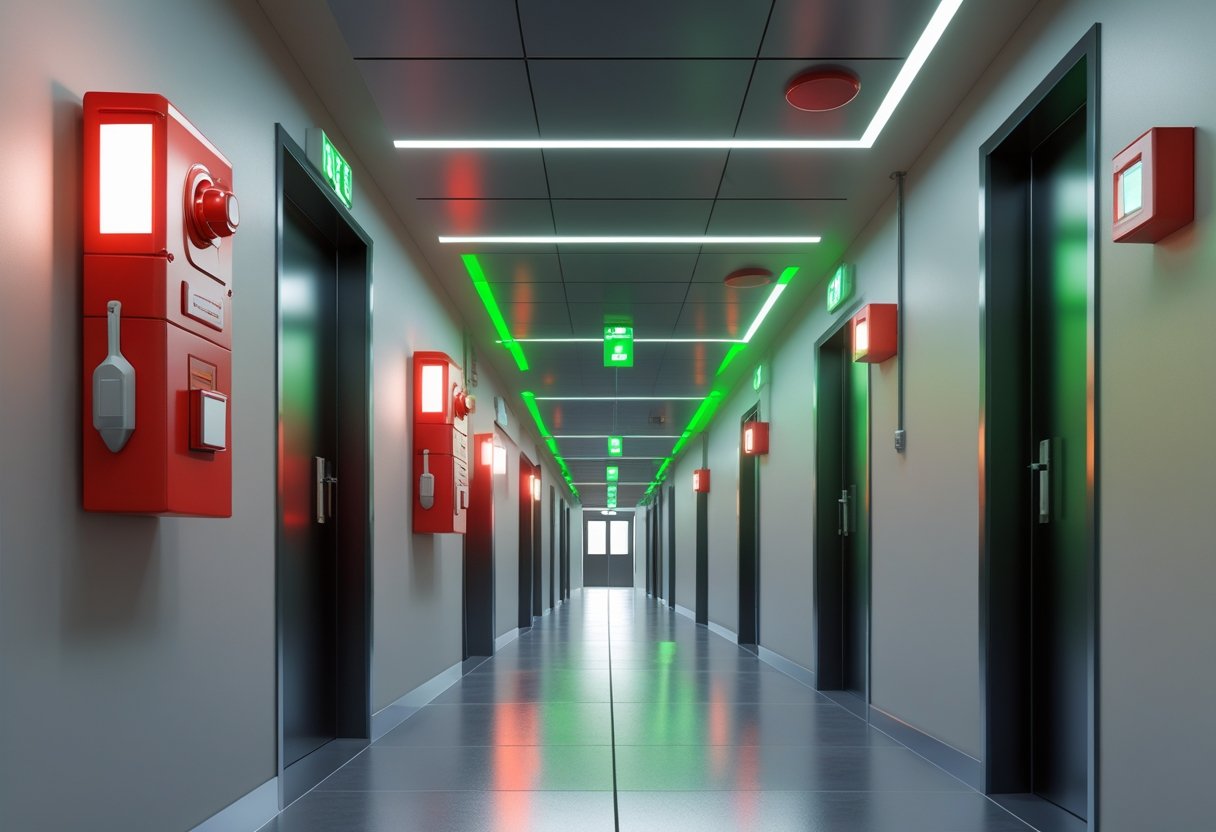When it comes to ensuring safety in any building, understanding fire alarm and emergency lighting systems is crucial. These systems not only protect lives but also serve to minimize property damage during emergencies. By integrating a reliable fire alarm system with effective emergency lighting, you create a safer environment that facilitates a swift evacuation when it matters most.
In the greater Houston area, compliance with local safety codes and regulations is essential for businesses and residences alike. You need to ensure that your fire alarm and emergency lighting systems meet the latest standards, allowing your building to function safely even during unexpected events. The right systems can help occupants navigate safely through smoke and darkness, reducing the panic often experienced in emergencies.
Choosing the right installation and maintenance services is vital for optimal performance. You deserve a system that is not only effective but also tailored to your specific needs. Knowledge of your options can greatly impact your safety strategy, ensuring that you and your occupants are well-protected.
Fundamentals of Fire Alarm and Emergency Lighting Systems
Fire alarm and emergency lighting systems play a critical role in ensuring safety during emergencies. Understanding their purpose, key components, and how they integrate is essential for effective life safety solutions in buildings.
Purpose and Importance
Fire alarms serve to detect smoke or fire and alert occupants through audible alarms and visual signals. This early warning allows people to evacuate safely, reducing the risk of injury or fatalities.
Emergency lighting systems activate during power failures or emergencies, providing illumination to guide occupants to exits. They significantly decrease panic by ensuring visibility, especially in dark or smoke-filled environments.
Both systems work together to enhance life safety and meet legal compliance mandates, ensuring buildings are prepared for emergencies.
Key Components Overview
A fire alarm system typically consists of:
- Detection Devices: These include smoke detectors, heat detectors, and manual pull stations.
- Notification Appliances: Horns, strobes, and voice alarms inform occupants of emergencies.
- Control Panel: This is the brain of the system, managing input from detectors and instructing notification appliances to activate.
For emergency lighting systems, key components include:
- Emergency Lights: These lights turn on automatically during power outages.
- Battery Backup: Ensures lights function when the main power supply is interrupted.
- Exit Signs: These are illuminated to guide occupants to safety.
Integration of Fire Detection and Lighting
Integrating fire alarm and emergency lighting systems is essential for cohesive emergency response. In modern installations, the fire alarm system can activate emergency lighting automatically.
When the fire alarm is triggered, emergency lights should illuminate at full brightness. This overrides any other lighting controls, such as dimmers or occupancy sensors, ensuring maximum visibility.
Such integration minimizes evacuation time and reduces confusion during emergencies. It's a coordinated effort to enhance the protection of life and property in buildings, particularly in the greater Houston area, where adherence to local codes and regulations is vital.
Essential Regulatory Standards and Codes
Understanding the essential regulatory standards and codes for fire alarm and emergency lighting systems is critical for compliance and safety. You must navigate through the specific requirements set by authoritative bodies to ensure your systems meet all necessary guidelines.
NFPA 101: Life Safety Code
NFPA 101, also known as the Life Safety Code, is a key document outlining the minimum requirements for building design, construction, and occupancy. This code focuses on life safety from fire and related hazards, ensuring that occupants have safe exits during emergencies.
Key elements include:
- Egress Requirements: Defines the number and width of exits based on occupancy load.
- Emergency Lighting: Mandates that emergency lighting must illuminate exits and paths clearly.
- System Maintenance: Stipulates requirements for regular inspections and testing of both fire alarm and emergency lighting systems.
Compliance with NFPA 101 is essential for safeguarding lives and property.
Role of Authority Having Jurisdiction
The Authority Having Jurisdiction (AHJ) plays a critical role in enforcing fire safety codes. This entity may vary from local fire marshals to building inspectors, and its decisions impact your compliance obligations.
You should expect the AHJ to:
- Review Plans: Assess and approve design plans for fire alarm and emergency lighting systems.
- Conduct Inspections: Perform regular inspections to ensure adherence to codes such as NFPA 101.
- Oversee Permits: Issue permits and provide guidance on necessary improvements to meet safety standards.
Engaging with the AHJ ensures that your strategies align with local safety regulations.
Updates and Compliance Requirements
Staying current with updates to fire safety codes is vital for maintaining compliance. NFPA 101 and other related standards undergo periodic revisions, which may introduce new requirements that impact your systems.
Important considerations include:
- Continuous Education: Regularly update your knowledge about changes to NFPA standards.
- Annual Inspections: Conduct yearly inspections of fire alarm and emergency lighting systems as per compliance mandates.
- Documentation: Maintain accurate records of inspections, testing, and maintenance for accountability.
In Greater Houston, adherence to these evolving standards is key to protecting life and ensuring operational integrity.
System Design and Planning Best Practices
Effective design and planning for fire alarm and emergency lighting systems are crucial in ensuring the safety of building occupants. Focus on integrating reliable components and following clear strategies to navigate these systems' complexities.
Emergency Lighting Design Strategies
When designing your emergency lighting system, prioritize compliant illumination levels. Consider local codes that dictate minimum brightness in egress paths, such as maintaining at least 1 foot-candle in illuminated areas.
Incorporate centralized battery systems for reliability and perform periodic testing to ensure functionality. Using LED fixtures can enhance energy efficiency and extend the system's lifespan.
Plan for placement in high-traffic areas and at key decision points, such as exits and stairwells. Ensure lights are spaced appropriately to eliminate shadowed areas that could hinder evacuation.
A documented maintenance schedule is essential to address any issues promptly and test battery life regularly.
Selecting Fire Alarm Components
Choosing the right fire alarm components is fundamental for effective detection and response. Start by selecting a control panel that meets your building's specific needs.
Opt for addressable systems which allow for quicker identification of activated zones. Detectors should include a mix of smoke, heat, and multi-sensor units to ensure a comprehensive approach.
Incorporate alarm notification appliances such as horns and strobes that are clearly audible and visible throughout the premises. This improves emergency communication significantly.
Additionally, ensure your system integrates seamlessly with other safety systems, allowing for synchronized operation during emergencies.
Pathway and Egress Illumination
Pathway and egress illumination play a vital role in guiding occupants safely to exits during emergencies. Clearly marked exits are non-negotiable; every pathway must have visible signs and adequate lighting.
Utilize a mix of directional and task lighting to enhance visibility. Highlight edges and steps along pathways to prevent accidents during evacuations. The National Fire Protection Association (NFPA) recommends specific lighting levels that vary based on building occupancy and layout.
Consider battery backup options that ensure illumination remains operational during power outages. It's also essential to conduct regular drills to test these systems and familiarize occupants with the evacuation routes.
Installation, Power Supply, and Controls
In the installation of fire alarm and emergency lighting systems, the focus is on integrating the components efficiently and ensuring reliable power supply. Understanding how each part functions together is crucial for optimal performance.
Emergency Generator Integration
Integrating an emergency generator into your fire alarm and emergency lighting systems provides a reliable power source during outages. This generator should be sized properly based on the expected load from both systems.
Make sure to connect the generator to critical circuits, including fire alarms, emergency lights, and exit signage. Regular testing and maintenance of the generator are essential to ensure it performs when needed, so establishing a routine check is advisable.
Role of Control Panels
Control panels serve as the brain of fire alarm systems, coordinating various components and ensuring they function together seamlessly. These panels monitor inputs from smoke detectors, manual pull stations, and other sensors, triggering alarms when necessary.
The control panel also manages emergency lighting systems, determining when to activate lights during emergencies. Ensure that your control panel is accessible and maintained properly for effective operation.
Automatic Activation and Overrides
Automatic activation of emergency lighting is vital during a fire alarm event. Upon detection of smoke or heat, the emergency lights should illuminate at full brightness. This feature overrides standard lighting controls, ensuring visibility for a safe evacuation.
In high-occupancy areas, this system minimizes panic by guiding occupants effectively. Consider implementing additional overrides, such as fire alarm tie-ins, to enhance safety further. This integration ensures that in emergency situations, lighting does not rely on manual controls, which could fail under stress.
Testing, Maintenance, and Reliability
Regular attention to fire alarm and emergency lighting systems is essential for ensuring safety in any building. This section will highlight the importance of routine inspections, measures to ensure system reliability, and the significance of comprehensive documentation.
Routine Inspections and Testing
You must perform routine inspections and testing of your fire alarm and emergency lighting systems. This includes visual checks for any visible damage and functional tests to verify operation.
Key Frequency Guidelines:
- Monthly: Test emergency lighting batteries and bulbs.
- Quarterly: Ensure fire alarm systems are functional through comprehensive testing.
- Annually: Conduct full maintenance checks by certified professionals.
Regular inspections help identify issues before they escalate, ensuring all systems are operational when needed.
Ensuring System Reliability
Reliability is critical for fire alarm and emergency lighting systems. To maintain reliability, implement a routine maintenance schedule that includes both preventative and corrective measures.
Essential Maintenance Tasks:
- Replace batteries in emergency lighting systems every 1-3 years.
- Clean smoke detectors and test alarms for proper functionality.
- Ensure wiring and connections are secure and free of damage.
By adhering to these tasks, you enhance the likelihood that your systems will perform effectively during an emergency.
Documentation and Recordkeeping
Thorough documentation and recordkeeping are vital for compliance and safety. Maintain detailed records of all inspections, tests, and maintenance performed on your fire alarm and emergency lighting systems.
Records should include:
- Dates of inspections and tests.
- The names of technicians performing the assessments.
- Findings and any corrective actions taken.
Proper documentation not only aids in compliance with local regulations but also helps track the history and performance of your systems, ensuring you maintain a safe environment in the greater Houston area.
Frequently Asked Questions
In this section, you will find answers to common questions regarding fire alarm and emergency lighting systems. These FAQs present essential information about installation requirements, compliance standards, and operational specifics that are crucial for safety in commercial environments.
What are the installation requirements for fire alarm systems in a commercial building?
Installation requirements for fire alarm systems include compliance with local building codes and the National Fire Protection Association (NFPA) standards. You need to ensure proper placement of detectors and alarms to achieve maximum coverage.
Additionally, systems should be installed by certified professionals to ensure functionality and compliance. Conduct a thorough risk assessment to determine the appropriate types and numbers of devices required.
How frequently should fire alarm systems be tested and maintained?
Fire alarm systems should be tested at least once a month to verify that all components are functioning properly. In addition, an annual comprehensive inspection is recommended to ensure long-term reliability and compliance with safety standards.
Regular maintenance checks can help identify issues before they become serious problems, ensuring the safety of building occupants.
What are the differences between manual and automatic fire alarm systems?
Manual fire alarm systems require human intervention to activate, such as pulling a lever or pressing a button. This type is often found in smaller buildings where immediate responses are manageable.
Automatic systems, on the other hand, detect smoke or heat and automatically trigger alarms without human action. These systems are highly effective in larger facilities where quick detection is crucial.
What are the code compliance standards for emergency lighting in public spaces?
Emergency lighting systems must adhere to local building codes as well as the NFPA 101 Life Safety Code. These standards specify minimum illumination levels and ensure that emergency exit paths are clearly marked.
Compliance ensures that occupants can safely evacuate in case of an emergency, providing critical guidance during power outages or other hazardous situations.
How do emergency lights function during a power failure?
Emergency lights utilize battery backup systems that activate when there is a power failure. These batteries provide illumination for a specified duration, typically anywhere from 90 minutes to several hours.
This functionality is crucial for guiding occupants toward exits safely and efficiently in the event of an emergency.
What should be considered when selecting fire alarm systems for a warehouse?
When selecting fire alarm systems for a warehouse, consider factors such as the size of the facility, layout, and types of materials stored. High ceilings and large open spaces may require specialized detection systems to ensure effective coverage.
Additionally, ensure that the system chosen can integrate with other safety systems, such as sprinklers or emergency lighting, for a comprehensive safety approach.
.svg)



.svg)


.svg)



